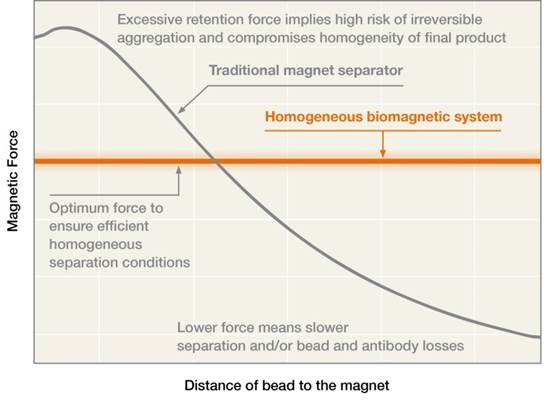Working with a magnetic separation rack, at small volumes it is easy to create and use a quadripol electromagnet to generate high forces during biomagnetic separation processes, even to the point of making the process very close to homogeneous. The main advantage to using electromagnets for this type of process is the ability to easily modify the current passing through the magnetic coils, thus modifying the value of the magnetic field and force during the setup of your process.
This post is about biomagnetic separation with a magnetic separation rack, and how to scale-up this process. If you are interested in this topic, download our free ebook The Basic Guide to Scale-up Biomagnetic Separation Processes:
At small volumes the number of ampere-turns (called the ‘magnetomotive force’) necessary to generate the force is quite small. The dimensions of the system coils are also small, so the resistance is small and the heat generated is negligible and can be easily dissipated (heat = (resistance of the coil) * (electrical current)^2).
Working in a magnetic separation rack with higher volumes
As you increase volumes, the dimensions of the iron pole parts and the yoke increase proportionally to the working volume. In addition, the magnetomotive force (the number of ampere-turns) needs to increase in order to maintain a constant magnetic field gradient.
This means that you need to increase the variation of the field proportionally with the radius of the vessel. It also means that you need to increase either the resistance or significantly increase the weight of the copper coil. Therefore the resulting electromagnet will be extremely heavy, would require a large amount of electrical power and the great amount of electrical power will generate a great deal of resistive heat that will need to be removed or dissipated.
In order to remove the heat from a scaled up electromagnetic device, a cooling system will be necessary in order to control the temperature. Cooling systems require water flow, costing the lab more in development and maintenance costs.
Magnetic separation rack using permanent magnets
In contrast, magnetic separation racks based on permanent magnets with modern materials are much lighter for the same working volume and magnetic force. No electrical power or cooling systems are needed with these permanent magnet separation racks, no maintenance, no power supply that can fail, and none of the other technical issues that are related to electromagnets (e.g. electromagnetic compatibility, interference, etc.) are seen with permanent magnets.
The only reason one would want to use an electromagnet is if they do not know the conditions and will have to vary the conditions of their process on a small scale. If you know the conditions, such as in a fixed homogeneous biomagnetic separation system and want to permanently scale up your process, however, permanent magnets are the most reasonable option.
Don't forget to check these posts from our blog in order to get a deeper insight into the scaling-up of biomagnetic separation processes:
- What are the Safety Issues with Large Magnetic Separation Systems?
- What is the Best Way to Scale Up the Separation Time Parameter?
- What is the Best Way to Scale Up When Different Volumes are Required?
Check www.sepmag.eu/ebooks to access to FREE eBooks on the subject, or contact us. We will be glad to help you to achieve an efficient magnetic bead separation process!





